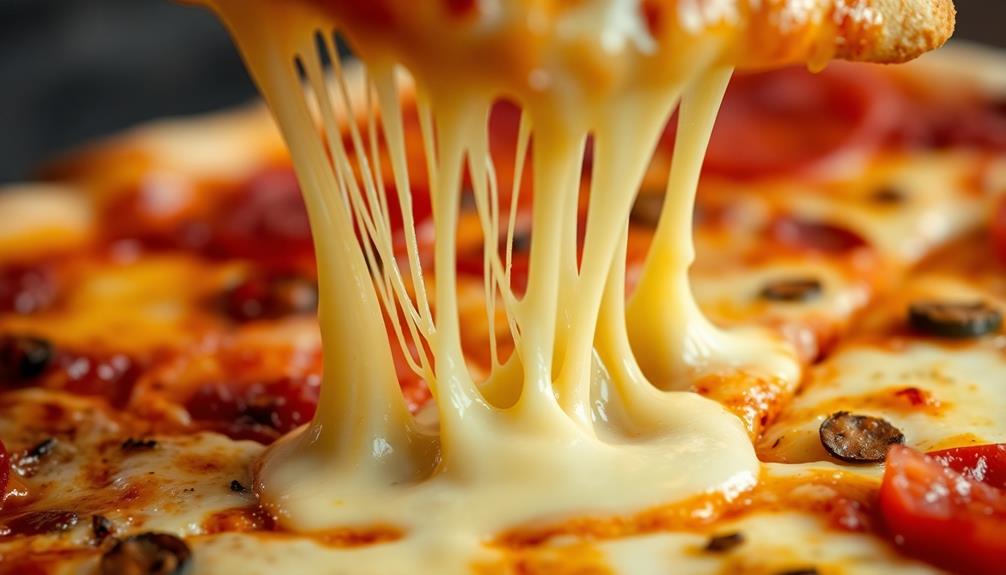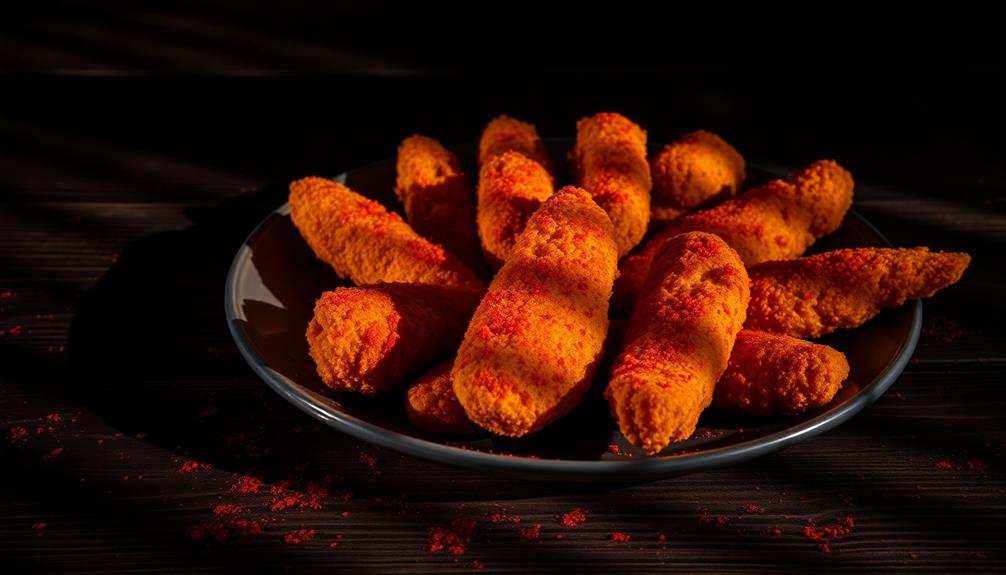The perfect cheese pull hinges on several key factors, like moisture, fat content, and cheese type. You'll want to choose high-moisture cheeses like mozzarella, which excel in stretchiness due to their protein structure. When cheese is heated, the proteins relax, allowing that gorgeous stretchy effect to occur. The ideal pH also plays a role; lower pH cheeses melt better, while higher pH varieties lose elasticity. With the right techniques, like even heating and proper resting, you can achieve that irresistible pull. Keep exploring the fascinating science, and you'll uncover even more secrets to mastering cheese pulls!
Key Takeaways
- The ideal cheese for a perfect pull has high moisture and fat content, such as mozzarella or muenster, enhancing meltability and stretchiness.
- Acidity levels and pH significantly influence cheese pull, with lower pH cheeses often yielding better fusion and stretch.
- The temperature during melting affects the protein structure, allowing for optimal relaxation and stretch in the cheese.
- Fresh cheeses provide better cheese pulls than aged varieties due to their higher moisture content and softer texture.
- Proper melting techniques, like using low to medium heat, prevent fat separation and ensure even melting for the best cheese pull experience.
History of Cheese

The history of cheese is a fascinating journey that dates back to ancient civilizations, where ingenious merchants accidentally discovered cheese-making by transporting milk in sheep stomachs. This serendipitous event laid the foundation for a beloved food that has evolved over millennia.
With over a thousand varieties of cheese today, production techniques have changed considerably, influenced by regional ingredients and cultural traditions. For instance, the diverse Chinese cuisine includes unique dishes that pair beautifully with cheese, showcasing the culinary fusion that can occur across cultures.
As you explore different types of cheese, you'll find that each culture has unique cheese-making practices. For instance, Mediterranean feta and Italian pecorino romano highlight the rich diversity in cheese history. These traditions not only showcase the variety of flavors and textures but also reflect the local environment and customs.
Throughout history, cheese-making has utilized specific bacteria and molds, shaping modern cheese production and flavor profiles. The global demand for cheese has surged, with production reaching approximately 22 billion kilograms annually.
This impressive figure underscores cheese's integral role in various culinary traditions worldwide. As you savor different cheeses, you're partaking in a rich history that spans civilizations, bringing taste and culture together in every bite.
Cheese Making Process
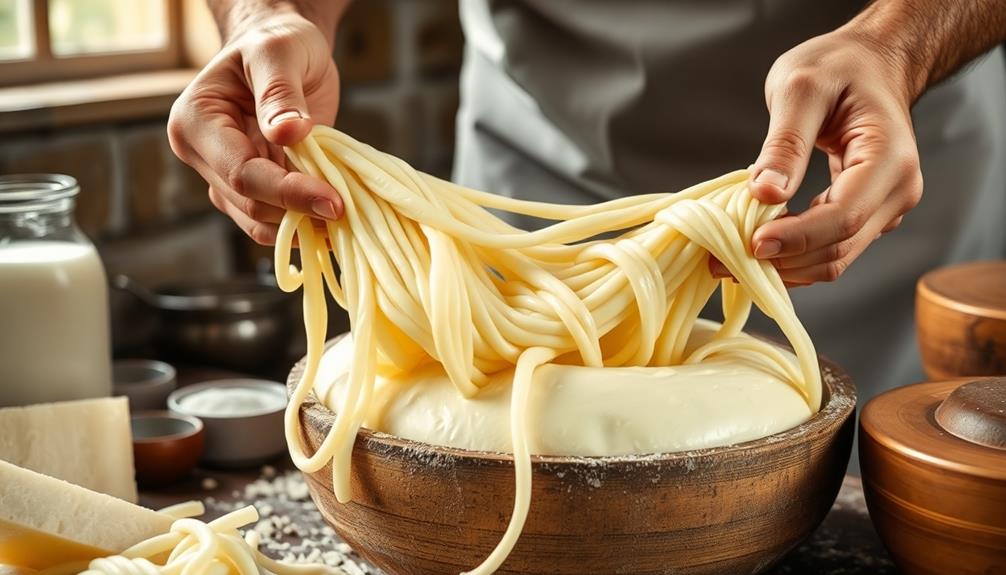
When you start making cheese, the first step is pasteurizing the milk to eliminate any harmful pathogens. This process is essential for ensuring the safety and quality of the final product.
Then, you add rennet to coagulate the milk, creating curds that will eventually become your cheese. The use of fresh ingredients, much like the way Brazilian cuisine highlights local flavors, can greatly influence the taste and texture of the cheese.
Milk Pasteurization Importance
Pasteurizing milk is essential in cheese making, as it effectively reduces harmful pathogens and enhances the milk's quality. By heating the milk to temperatures between 70-72°C for 15-20 seconds, you kill off undesirable bacteria while preserving the flavor and quality of the milk. This step is critical for ensuring food safety and improving the overall texture of your cheese.
Additionally, the importance of using high-quality milk can be likened to the careful selection of ingredients in traditional dishes like Agnolotti, where each component plays a significant role in the final product.
During pasteurization, the protein structures, particularly casein, undergo alterations that make them more suitable for coagulation. This change is essential for achieving the right consistency in your final product. With unwanted bacteria eliminated, you can safely introduce specific starter cultures that contribute to the unique flavors and characteristics of various cheese types.
It's important to control the temperature and time precisely during pasteurization. If not done correctly, you risk spoilage or unwanted changes in the milk's composition, which can severely affect the quality of your cheese.
In fundamental terms, proper milk pasteurization lays the foundation for a successful cheese-making process, ensuring that each batch is safe, flavorful, and ready for that perfect cheese pull you're aiming for.
Coagulation With Rennet
Rennet's role in cheese making is nothing short of transformative, turning liquid milk into a semisolid curd that forms the backbone of your favorite cheeses. When you add rennet to pasteurized milk, typically cooled to around 30-32°C, it initiates coagulation by cleaving the kappa casein proteins. This action destabilizes the casein micelles, allowing them to form a gel-like structure that captures fat and water, creating the essential casein network.
Similar to the process used in making Dorayaki (Red Bean Pancake), where specific techniques and temperatures are vital for texture, the cheese-making process requires precise control for ideal results.
The amount of rennet you use is significant; it's carefully measured based on the milk's volume and the desired firmness of the curd. Too much rennet can result in overly firm curds, while too little leads to softer ones.
Once you've added the rennet, you'll need to wait patiently as the curds form, which usually takes between 30 minutes to 2 hours. This coagulation time can vary depending on the milk composition and rennet strength.
Understanding this process is key to achieving that perfect cheese pull you crave. The quality and structure of the casein network directly influence the melting characteristics of the cheese, paving the way for that delightful stretch when you take a bite.
Role of Salting
Once the curds have formed and you've achieved that perfect coagulation, salting takes center stage in the cheese-making process. Salting isn't just about flavor; it's essential for preservation and moisture regulation, which are vital for developing that ideal cheese pull. There are two primary methods of salting: dry salting, where you apply salt directly to the cheese's surface, and brine salting, which involves soaking the cheese in a saltwater solution.
| Method | Description | Purpose |
|---|---|---|
| Dry Salting | Salt applied directly to surface | Enhances flavor and texture |
| Brine Salting | Soaking in a saltwater solution | Regulates moisture content |
| Salt Quantity | Affects pH levels | Influences melt properties |
| Bacterial Control | Inhibits undesirable bacteria | Improves cheese quality |
The amount of salt you add can greatly influence the cheese's pH level, with lower pH promoting better melt and stretch properties. Proper salting techniques help manage moisture and fat content, leading to a more elastic and stretchable cheese structure, ensuring that perfect cheese pull you crave.
Factors Influencing Cheese Pull
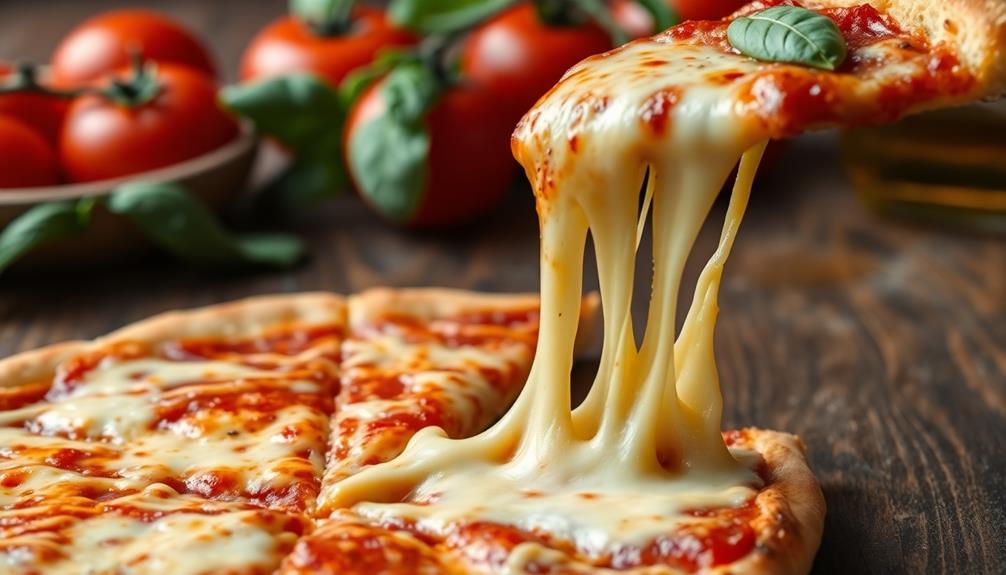
When it comes to achieving that perfect cheese pull, several key factors come into play. First, the acidity level of the cheese matters greatly. Lower pH levels promote better fusion of casein molecules, resulting in a superior cheese pull.
Additionally, moisture content influences stretchability; high-fat cheeses tend to deliver a better cheese pull than their drier counterparts. For instance, creamy cheeses like mozzarella are popular in various culinary traditions, such as Asian Cuisine, where they complement a range of dishes.
Temperature and the integrity of the casein protein network also impact cheese pull. Warmer temperatures help the proteins relax, enhancing stretchability. Furthermore, the milk fat content plays a role in the overall quality of the cheese pull.
Aging cheese affects its texture through proteolysis, which can enhance meltability. However, excessive breakdown may negatively impact stretch, as it breaks bonds within the casein matrix.
Role of Proteins
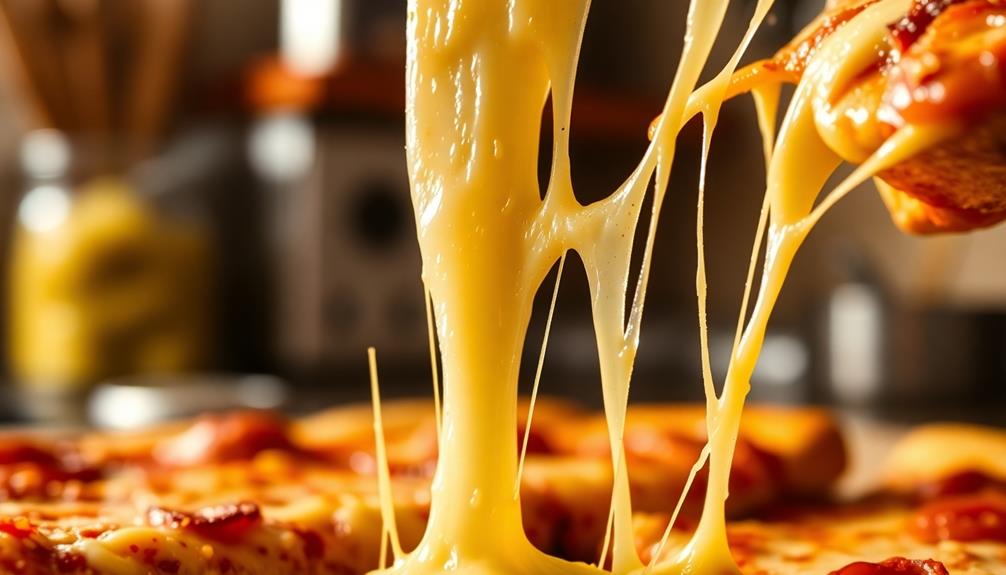
Proteins play a vital role in creating that coveted cheese pull, primarily through the structure and behavior of casein. Casein molecules serve as the primary structural components of cheese, forming a network that dictates its elasticity and stretchability.
When cheese is heated, denatured serum proteins expose reactive sulfhydryl groups, which then form covalent bonds with K-casein. This interaction enhances the melting and stretching properties, giving you that desired cheese pull. Dishes like a Loaded Baked Potato also benefit from the way proteins interact with other ingredients, contributing to the overall texture and flavor experience.
During cheese ripening, proteolysis occurs, hydrolyzing the casein matrix. This process softens the texture and greatly influences the meltability of the cheese. The integrity of the casein network is essential; if disruptions happen in this structure, you'll likely experience a reduction in stretch.
Moreover, the balance of different casein types and their interactions with whey proteins can dramatically affect the overall melting and stretching characteristics of cheese.
Ideal Cheese Selection

When you're aiming for the perfect cheese pull, choosing the right cheese is essential.
Look for cheeses like mozzarella or muenster that offer high moisture and fat levels, as these traits enhance stretchiness and meltability.
For instance, using a cheese that's often paired with seasonal dishes, such as burrata in a Grilled Peach and Burrata Salad, can elevate the flavor experience.
Also, keep in mind how pH levels affect melting, since they can make a big difference in your cheese pull experience.
Cheese Types for Stretch
To achieve that perfect cheese pull, you'll want to seek out cheeses known for their stretchiness. The right melted cheese can elevate your dish, making it a delightful experience, much like the satisfying texture of Elote that combines flavors and textures beautifully.
Here are three cheeses that excel in creating that sought-after cheese pull:
- Muenster: Often considered superior to mozzarella, Muenster offers an elastic texture that stretches beautifully when melted.
- Mozzarella: The classic choice for a reason, fresh mozzarella is renowned for its high moisture and fat content, making it ideal for a gooey cheese pull.
- Fontina: With its creamy texture and excellent meltability, Fontina is perfect for dishes that need a luscious stretch.
Young cheeses like fresh mozzarella typically melt better than aged varieties, which tend to be firmer and less stretchy.
The key is finding cheeses with a higher moisture content, as they yield a superior cheese pull.
Moisture and Fat Levels
Choosing the right cheese goes beyond just picking a type; moisture and fat levels play a key role in achieving that perfect cheese pull. The moisture content of cheese greatly impacts its meltability and stretchiness. Higher moisture levels typically yield a better cheese pull, while a fat content of at least 20% enhances the creamy texture when melted. Fresh, young cheeses are your best bet since they usually have higher moisture and fat, making them ideal for dishes needing that gooey stretch.
Here's a quick comparison of cheese types based on moisture and fat levels:
| Cheese Type | Moisture Content | Fat Content |
|---|---|---|
| Fresh Mozzarella | High (moist) | 20%+ |
| Provolone | Medium | 25% |
| Gouda | Medium to Low | 28% |
| Aged Cheddar | Low | 30% |
For the best cheese pull, aim for cheeses like mozzarella that balance moisture and fat effectively. This combination will guarantee your cheese adheres and stretches beautifully in your culinary creations.
Ph Impact on Melt
Understanding the pH level of cheese is essential for achieving that perfect cheese pull, as it directly affects meltability and stretch. The pH influences how the proteins behave when heated, impacting the overall texture of your cheese melts.
For instance, when preparing dishes like Mushroom Masala, the right cheese choice can enhance the overall flavor profile. Here are three key points to remember:
- Lower pH Cheeses: Cheeses like mozzarella have a neutral to slightly acidic pH, allowing for ideal meltability and stretch. This makes them perfect for that gooey cheese pull you crave.
- Higher pH Cheeses: Aged cheeses, such as cheddar, have a higher pH, resulting in firmer textures that don't melt as easily. This limits their stretchability and can disappoint in melting applications.
- Balanced pH Choices: Young varieties of gouda or muenster strike a balance, providing excellent melting and stretch characteristics. These options can help you achieve impressive cheese pulls in your culinary creations.
Melting Techniques
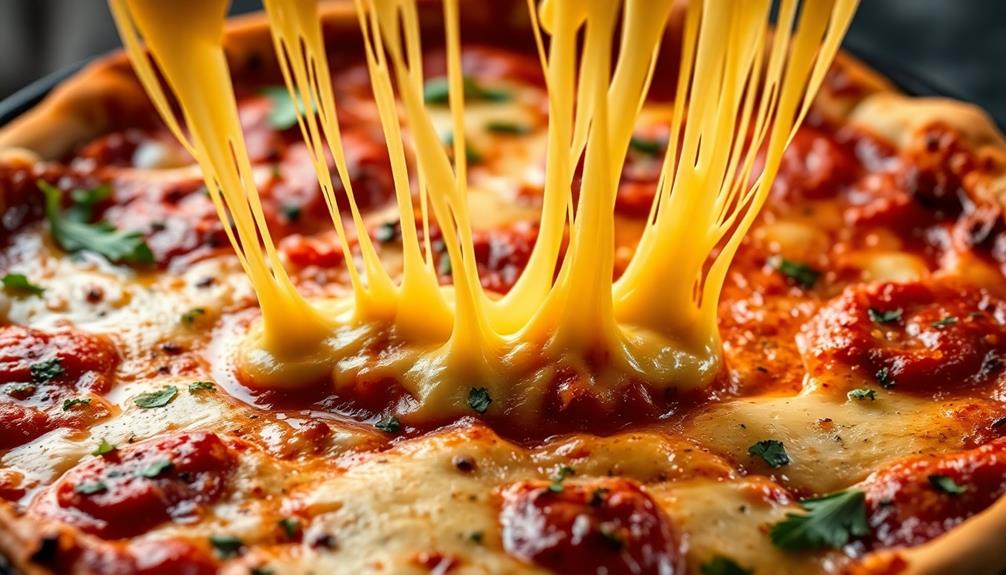
Achieving the perfect cheese pull hinges on mastering melting techniques. To start, selecting the right cheese is essential. High-fat cheeses like mozzarella and muenster melt beautifully and yield that coveted stretch.
Incorporating a side of Horiatiko Psomi (Country Bread) to complement your dish can enhance the overall dining experience. When making grilled cheese, cooking at low to medium heat is key. This approach allows the cheese to melt evenly without the risk of fat separation, which can lead to a greasy texture.
If you're working with pizza, consider pre-slicing the raw dough before adding cheese. This technique enhances heat circulation, ensuring your cheese melts uniformly.
Once your cheese is melted, resist the urge to slice immediately; allowing it to rest briefly maintains its stretchiness and prevents it from breaking apart.
Cultural Impact of Cheese Pull

The cheese pull phenomenon has taken the culinary world by storm, becoming a visual centerpiece on social media platforms like Instagram, where over 60,000 posts proudly display #cheesepull.
This trend not only showcases the allure of cheese strands but also highlights its significant cultural impact.
Here are three ways cheese pulls have influenced food culture:
- Visual Appeal: Food photography thrives on the mesmerizing sight of gooey cheese strands, making it a marketing goldmine for restaurants and brands.
- Emerging Trends: Culinary innovations, like gourmet grilled cheese sandwiches, emphasize the cheese pull as a pivotal part of the dining experience, attracting food enthusiasts.
- Emotional Connection: The perfect cheese pull stirs nostalgia and cravings, shaping consumer preferences and boosting demand for cheesy dishes in eateries.
Fast-food chains have also recognized the power of cheese pulls, incorporating them into their marketing strategies to enhance menu visuals and attract customers.
As you scroll through your feed, it's clear that the cheese pull isn't just about food; it's a cultural phenomenon that brings people together, evoking shared experiences and delightful cravings.
Frequently Asked Questions
How to Get the Best Cheese Pull?
To get the best cheese pull, choose high-moisture, high-fat cheeses, cook at low to medium heat, and let your dish cool slightly before serving. Experiment with different cheese combinations for ideal stretch and texture.
What Is the Science Behind Cheesemaking?
Imagine a canvas, where milk transforms into art. You pasteurize, add cultures, and coax curds to life. The balance of moisture and fat guides your masterpiece, while aging deepens flavors, revealing the beauty of cheesemaking.
What Causes Cheese Pulls?
Cheese pulls happen when you heat cheese, causing its proteins to melt and stretch. Factors like acidity, fat content, temperature, and cheese's age all influence how beautifully that gooey stretch occurs when you pull it.
Which Cheese Gives the Best Pull?
Did you know that mozzarella boasts around 60% moisture content? When it comes to cheese pulls, you'll find mozzarella excels, but don't overlook Muenster, which can stretch even better due to its higher fat content.
Conclusion
In the world of cheese, the perfect cheese pull is like a magician's grand reveal—captivating and full of wonder. By understanding the science behind it, from the proteins at play to the ideal cheese selection, you can elevate your cheesy experiences. Whether you're melting it for a comforting dish or showcasing it at a gathering, mastering the art of the cheese pull transforms every bite into a delightful adventure. So go ahead, release your inner cheese wizard! And if you really want to impress your friends and family with your cheese pulling skills, try out the witch’s broomstick cheese straws recipe. With the right combination of cheeses and a few special techniques, you’ll have everyone oohing and ahhing as they watch the cheesy strands stretch and twirl like magic. So don’t be afraid to experiment and have fun with your cheese creations, because the cheese pull is a beautiful and enchanting thing. And remember, the key to a perfect cheese pull is using the right kind of cheese. Cheeses like mozzarella, cheddar, and gouda are known for their excellent melting capabilities, making them ideal choices for achieving that mesmerizing cheese pull. So next time you’re in the kitchen, give the witch’s broomstick cheese straws recipe a try and amaze your guests with your newfound cheese-pulling prowess. With a little practice and some experimentation, you’ll soon be enchanting everyone with your magical cheese creations.
